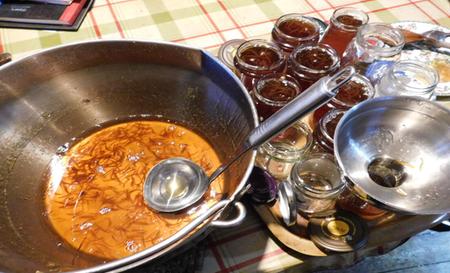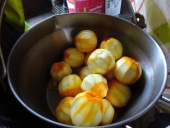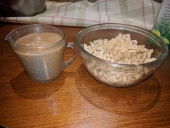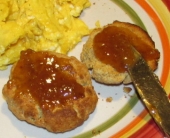

 13
13






How Permies works: https://permies.com/wiki/34193/permies-works-links-threads
My projects on Skye: The tree field, Growing and landracing, perennial polycultures, "Don't dream it - be it! "
Note: I'm UK based, and we don't tend to pressure can preserves like jam and marmalade. In my climate simple sterilisation of storage containers is adequate.












 5
5




Very Economical Marmalade:
450g/1lb Seville oranges
450g/1lb peel from sweet oranges and grapefruit
The peel can be frozen at any time of year until enough is collected to make marmalade or until seville season returns.
(aside note: As I often gift preserves to a vegan friend I never add butter to them, and it doesn't seem to make any difference)Cut each fruit in two, squeeze out all pips and put in piece of muslin tied with a long string.
put water (2.3l 4ptUK) in preserving pan add bag of pips tied to pan handle.
Put orange halves and skins through mincer into pan, and leave overnight.
Simmer with lid on for 15 mins then remove lid and simmer uncovered for 1 hour to reduce liquid by about half.
Add warmed sugar (1.8kg/4lb) Stir well to dissolve sugar then turn up heat to bring to a fast rolling boil with lid off. Stir occassionally.
After 10-15 mions test for a set and when setting point is reached remove pip bag. Remove pan from heat add butter to disperse jam
Stir again.
Let stand for about 5 mins to cool slightly, stir to redistribute peel, then pour into warmed jars.
How Permies works: https://permies.com/wiki/34193/permies-works-links-threads
My projects on Skye: The tree field, Growing and landracing, perennial polycultures, "Don't dream it - be it! "
 6
6




 1
1




"The only thing...more expensive than education is ignorance."~Ben Franklin. "We can easily forgive a child who is afraid of the dark; the real tragedy of life is when men are afraid of the light." ~ Plato
 6
6
















 6
6




How Permies works: https://permies.com/wiki/34193/permies-works-links-threads
My projects on Skye: The tree field, Growing and landracing, perennial polycultures, "Don't dream it - be it! "
 7
7




 6
6




 5
5




 5
5




 8
8




I just remembered that I've already posted the Christmas cake recipe in this thread
https://permies.com/t/40/152852/Quality-Fruitcake#1724355
 5
5




 7
7




 8
8




All true wealth is biological.
Lois McMaster Bujold
 2
2




Tereza Okava wrote:I did it this weekend! Your instructions were fabulous and it was sooooo much easier than any other marmalade I've ever made. And it did indeed firm up very nicely, with nothing finicky.
Alas, it is so bitter as to be inedible. I gave some to an English friend of mine who said it was even too bitter for him. I am a person who enjoys eating bitter greens and bitter melon, but even I can't eat it. I've been told to try it with salt and with butter but so far nothing cuts the bitter enough to make it edible.
Luckily the recipe was small, I'm only out 1.5 kg of sugar (got the fruit for free) and my time. But boooo, I was hoping for marmalade!
So if I want to try again with maybe half normal oranges and half rangpur, do I understand it is the acidity that makes it set up?
"The only thing...more expensive than education is ignorance."~Ben Franklin. "We can easily forgive a child who is afraid of the dark; the real tragedy of life is when men are afraid of the light." ~ Plato
 6
6




 4
4




"The only thing...more expensive than education is ignorance."~Ben Franklin. "We can easily forgive a child who is afraid of the dark; the real tragedy of life is when men are afraid of the light." ~ Plato
 6
6




 6
6




 5
5




 5
5




$10.00 is a donation. $1,000 is an investment, $1,000,000 is a purchase.












 4
4




How Permies works: https://permies.com/wiki/34193/permies-works-links-threads
My projects on Skye: The tree field, Growing and landracing, perennial polycultures, "Don't dream it - be it! "












 3
3




How Permies works: https://permies.com/wiki/34193/permies-works-links-threads
My projects on Skye: The tree field, Growing and landracing, perennial polycultures, "Don't dream it - be it! "
 5
5




Nancy Reading wrote:Hi Ellen, using a pressure cooker to cook the fruit is a good idea - it will probably soften and cook them more quickly so preserving more of the goodness. Also good for smaller amounts prehaps. Alas, I don't have a pressure cooker, perhaps one day....
You've made a fantastic array of citrus marmalade. I was thinking of trying to get a Yuzu tree. I think it might be hardy with me....
$10.00 is a donation. $1,000 is an investment, $1,000,000 is a purchase.
 5
5




 5
5




Nancy Reading wrote:Cécile, For some reason I always think of marmalade as made with citrus. I wonder what the difference is between jam and marmalade (that's a subject for another thread perhaps!) It's always useful to have different recipes to use when there is a glut though, so tomato marmalade is another option!
$10.00 is a donation. $1,000 is an investment, $1,000,000 is a purchase.












 4
4




Cécile Stelzer Johnson wrote:And I'm not sure if the distinction is in adding water to the marmalade while not adding any to a fruit jam? Perhaps it was to make more volume for a fruit that was considered a bit expensive?
How Permies works: https://permies.com/wiki/34193/permies-works-links-threads
My projects on Skye: The tree field, Growing and landracing, perennial polycultures, "Don't dream it - be it! "
 3
3





 6
6




Live, love life holistically












 2
2




How Permies works: https://permies.com/wiki/34193/permies-works-links-threads
My projects on Skye: The tree field, Growing and landracing, perennial polycultures, "Don't dream it - be it! "












 3
3




Nancy Reading wrote:I just saw your post Ulla. How wonderful having your own orange trees!
I guess your marmalade is a bit sweeter, using sweet oranges. Do you use the rest of the peels at all? Or are they just compost?
Live, love life holistically
 4
4




Cécile Stelzer Johnson wrote:
Nancy Reading wrote:Cécile, For some reason I always think of marmalade as made with citrus. I wonder what the difference is between jam and marmalade (that's a subject for another thread perhaps!) It's always useful to have different recipes to use when there is a glut though, so tomato marmalade is another option!
You know, Nancy, I feel the same way. To me, marmalade has to have some citrus fruit in it.
As a linguist, I am always intrigued by the etymology of some words. This one had me look it up because I've heard that a long time ago, quince was another fruit, not a citrus, made into a marmalade.
 10
10




 5
5




Finished 2 life quests (well... almost). Wondering what to do next? Zone 5b
 7
7




find religion! church
kiva! hyvä! iloinen! pikkumaatila
get stung! beehives
be hospitable! host-a-hive
be antisocial! facespace

|
Four score and seven years ago, our forefathers brought forth this tiny ad:
Play Your Way to a Sustainable Lifestyle: Uncover Permaculture Principles with Each Card
https://gardener-gift.com/
|








